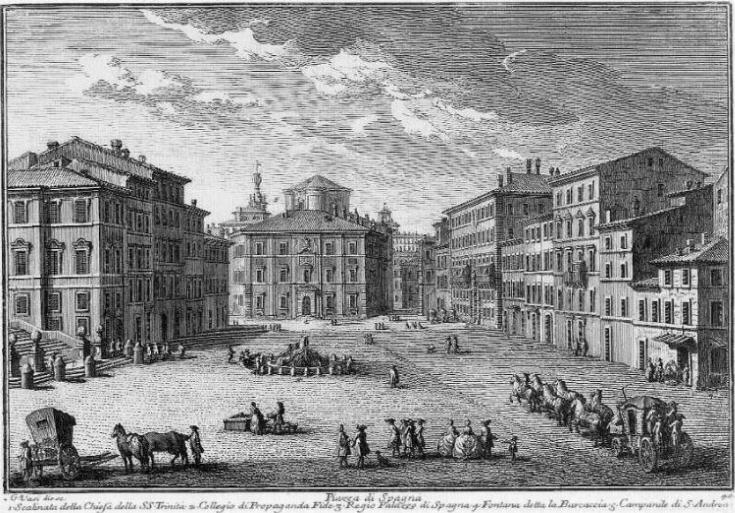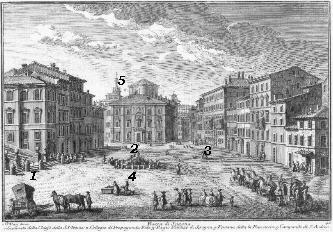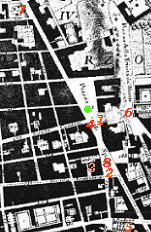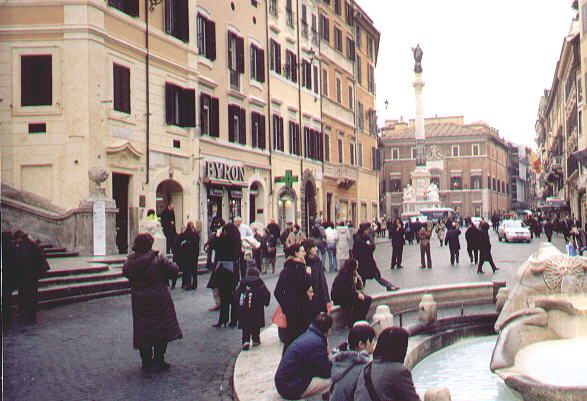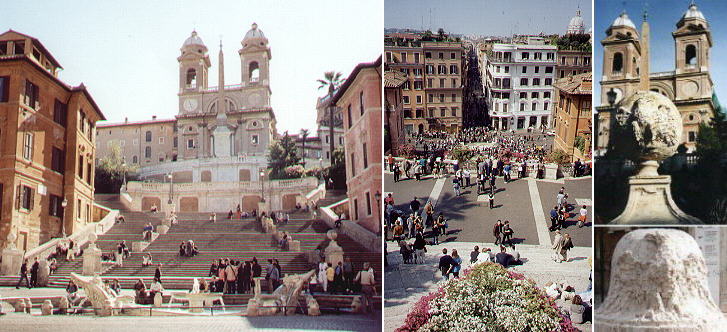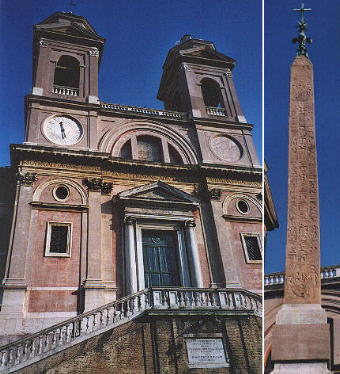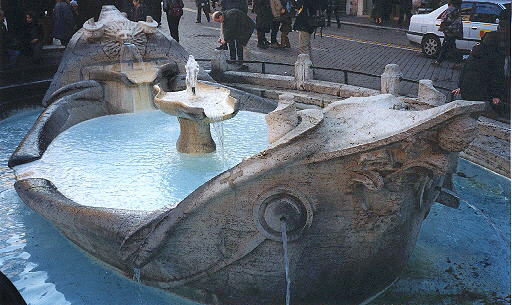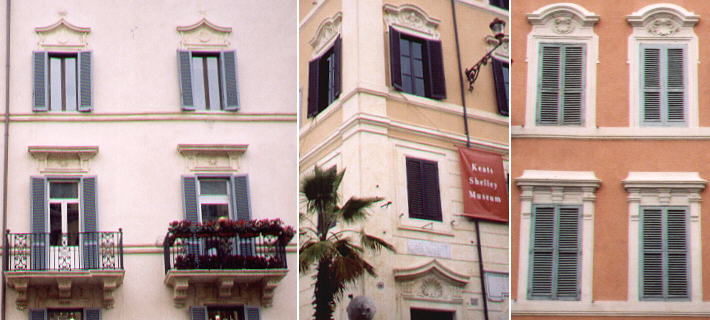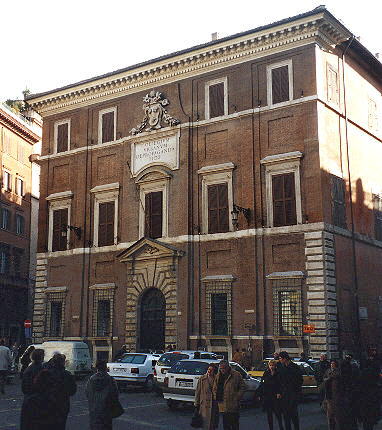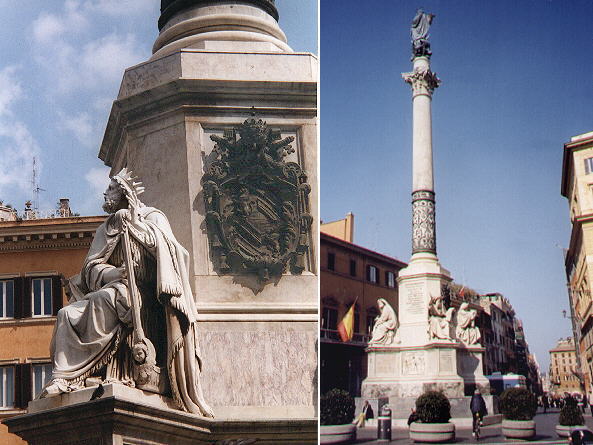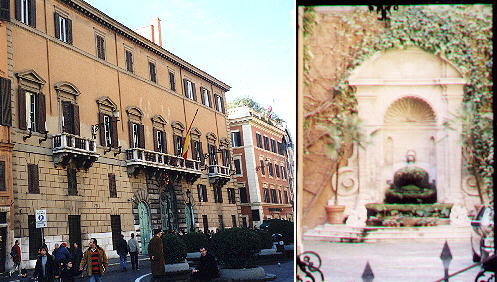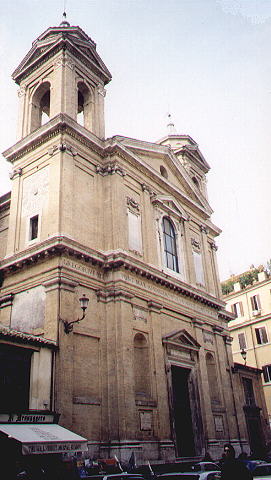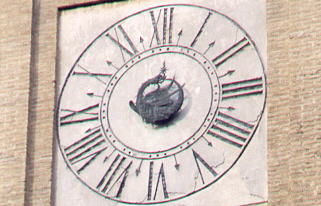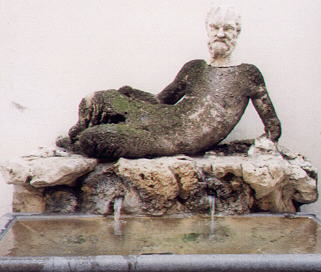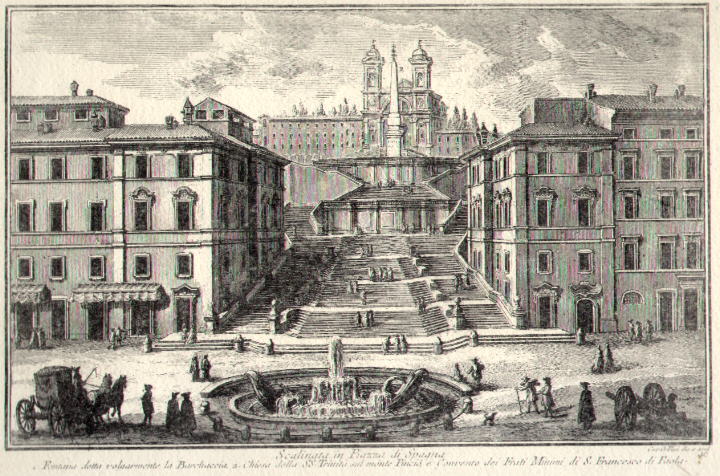

Piazza di Spagna (Book
2) (Map B2)
(Day 2) and
(Day 3)
(View C6) (Rione Campo Marzio)
In this page:
The plate by Giuseppe Vasi
Today's view
The Spanish Steps
Santissima TrinitÓ dei Monti
The fountain
The Strangers' Quarter
Palazzo di Propaganda Fide
Colonna dell'Immacolata
The Spanish Embassy
S. Atanasio dei Greci, Via del Babbuino and Teatro d'Alibert
Vasi's Second Plate for Piazza di Spagna
The Plate (No. 40)
Piazza di Spagna was at the center of the Strangers'
Quarter, the triangle made by Via del Corso, Via Frattina and Via del Babuino, where most
of the foreigners lived, in particular painters and sculptors.
It was named after the Spanish Embassy (on the right). Vasi preferred to show Piazza di Spagna
seen from the north-west giving emphasis to the Palace of Propaganda Fide by Gian Lorenzo Bernini
and to the
bell tower of S. Andrea delle Fratte
by Francesco Borromini. He showed Piazza di Spagna seen from the south-west (giving emphasis
to the Spanish Steps) in plate 128.The view is taken from the green dot in the map below.
In the description below the plate Vasi made reference to: 1) Steps leading to SS. TrinitÓ dei Monti; 2) Palazzo di Propaganda Fide; 3) Palazzo di Spagna; 4) Fontana della Barcaccia; 5) Campanile di S. Andrea delle Fratte. 5) is covered in another page.
The small 1785 map shows also 6) SS. TrinitÓ dei Monti; 7) S. Atanasio dei Greci; 8) Colonna dell'Immacolata.
Today
The only change relates to the Column of the Immacolata erected by
Pius IX in 1854. Otherwise what we see today is what Vasi shows in his plate (apart from the shopping crowds).
The Spanish
Steps
The Steps (called by the Italians Scalinata della TrinitÓ dei Monti) were built
in 1721-25 by Francesco de Sanctis to link the Piazza with the church
of TrinitÓ dei Monti. The curved lines of the Spanish Steps recall
Porto di Ripetta built in 1704
by Alessandro Specchi.
Costs were born by France (a donation had been made in 1655 by a French gentleman)
to which the church belonged and the
piers and the globes at the beginning of the steps have the fleurs-de-lis of the Bourbon
family together with the chequered eagle of Pope Innocentius XIII. John Keats lived and died in the pink house to the right of the steps.
Read Charles Dickens's account of the Roman models who used
to stay on the Spanish Steps.
Read William Dean Howells' 1908 account of this neighborhood.
SS.TrinitÓ dei Monti
The church was built in 1519, but the fašade was completed towards the end of the XVIth century. The steps were
built by Domenico Fontana in 1586-1588 and the coat of arms of Sixtus V is still
visible on the pillars. Both bell towers had a clock: one followed the Italian practice, while the other one followed the French practice (to learn more about the Italian hour click here).
In front of
the church Pius VI erected in 1789 an obelisk found near Porta Salara. The top of the obelisk shows a lily and a star which are heraldic symbols of Pius VI (to see all the obelisks of Rome click here).
The Fountain
The fountain was built by Pietro Bernini with the assistance of his son Gian Lorenzo
at a very low level because of poor water pressure. The fountain is decorated with the
sun of Urbanus VIII.
See
Filippo Juvarra's plate
of the coat of arms by G. L. Bernini.
The Strangers' Quarter
The Spanish Steps added a lot to the real estate value of Piazza di Spagna and almost all the existing buildings
were replaced by new ones. The new palaces, split into apartments and decorated with generic symbols, were rented
to the many foreigners who came to Rome. They stayed for extended periods usually from Christmas to the end of carnival or from
the last days of carnival to Easter: the objective was to see both some great religious ceremonies and the almost pagan frenzy of the Roman carnival.
Several buildings are decorated with a fleur-de-lis as they belonged to the French monks of TrinitÓ de' Monti.
John Keats lived in the palace at the center of the image: now it is in part
occupied by the Keats-Shelley Memorial with memorials of their Roman stay.
The Palace of Propaganda Fide
The building devoted to the propagation of the Roman catholic faith was also known as
Collegium Urbanum after Pope Urbanus VIII. Here pupils of many different nationalities
were educated as missionaries. The fašade is by Bernini.
See Filippo Juvarra's
plate of the coat of arms on the fašade. Borromini built another
fašade on the right side.
The Column of the
Immacolata
The column was erected in 1854 in honour of the "Immaculate Conception of the Virgin" a dogma
promulgated by Pius IX. On the top of the (old) cipolline column stands the bronze statue
of Mary; beneath are Moses, David, Isaiah and Ezechiel.
The Spanish Embassy
The building is still the Embassy of the Kingdom of Spain as the flag proves. Francesco Borromini
built inside a very fine entrance. The current unassuming fašade is a XIXth century work. From the entrance one can see a fine fountain in the courtyard (for more fountains in the courtyards of Rome click here).
S. Atanasio dei
Greci e Via del
Babbuino
In Via del Babbuino (Baboon, after the name given to an old statue of a silenus)
Giacomo Della Porta built for Gregorius XIII a church very similar to TrinitÓ dei Monti.
The hand of the clock is the Boncompagni dragon. Il Babbuino was one of the talking statues of Rome, together with
Marforio, Pasquino, Madama Lucrezia,
Abate Luigi and il Facchino (click here to learn more about il Babbuino and the Talking Statues of Rome).
A small street off Via del Babuino is
named Via del teatro d'Alibert after a theatre which was there until the first half of the
XIXth century. It was the largest theatre in Rome, especially known for operas and for
Carnival balls.
Vasi's Second Plate
The "target" of the 10 books published by Vasi between 1746 and 1761was not the travelling foreigner, but rather
the faithful pilgrim: this explains why in his view of Piazza di Spagna he chose to show Palazzo di Propaganda Fide, one of the most important Roman Catholic institutions, rather than
the Spanish Steps. Mariano Vasi, who continued to sell his father's books and etchings, realized that his
customers were mainly foreign travellers, in some cases even despisers of the Roman religious institutions. The original view of Piazza di Spagna was replaced by Scalinata (steps) in
Piazza di Spagna an etching falsely attributed to Giuseppe Vasi, because the obelisk at the top of the steps was erected in 1789, while Vasi passed away in 1782.
Excerpts from Giuseppe Vasi 1761 Itinerary related to this page:
Strada del Babuino
Da una brutta statua, che sta a giacere sopra un fonte prende il nome questa spaziosaa e nobile strada, la quale
cammina dritta sotto le falde del monte Pincio, che ne' tempi andati dicevansi orti di Napoli; ora per˛ sono
tutte occupate da nobili casamenti, e da chiese e conventi. In primo luogo si trova a destra la
Chiesa di S. Atanasio, e collegio dei Greci
Da Gregorio XIII. fu eretta questa chiesa, e collegio per li giovani di nazione Greca, acci˛ apprendessero le
scienze, e non si perdesse l'uso dell'antico rito e ceremoniale Greco. Ne fece il disegno Giacomo della
Porta; il prospetto della chiesa per˛ Ŕ di Martin Lunghi, e le pitture sono di Francesco Tibaldi.
Nell' ultimo vicolo quasi incontro evvi il magnifico
Teatro di Alibert detto delle Dame
Porta questo un tal nome dal suo facitore che con somma splendidezza e magnifica proporzione lo
distinse fra tutti gli altri, che sono in Roma destinati per li drammi musicali.
In questa contrada, che negli ultimi secoli dicevasi gli orti di Napoli, si crede essere stata la Naumachia
di Domiziano amplissima, nella quale radunavasi tant'acqua, che a guisa di un mare, vi sý facevano
i combattimenti navali per trattenimento del popolo Romano, e per esercitare ancora la giovent¨ a
guerreggiare per mare. Finita poi la battaglia, e ritiratesi le navi, spariva in un baleno tutta l'acqua con
piacere e maraviglia degli spettatori, e perchŔ il suolo restasse subito asciutto era tutto coperto di arene,
acci˛ in ultimo vi si celebravano i giuochi de' Gladiatori.
Piazza di Spagna
Dopo la divisata strada si slarga la magnifica piazza, che dicesi di Spagna non solo per il palazzo
dell'Imbasciatore di quel Monarca; ma ancora perchŔ Ŕ di giurisdizione del medesimo, e perci˛
Ŕ la pi¨ frequentata e abitata da' forestieri, e illustri viaggiatori; onde vi sono de' nobili
alloggiamenti, e degli antiquarj condottieri in abbondanza.
Scalinata e Fontana della barcaccia
Sulla medesima piazza corrisponde la grande scalinata fattavi dal Re Cristianissimo Luigi XIV. col disegno
di Franc. de Santi per rendere
agevole e maestoso l'accesso alla chiesa della ss. TrinitÓ de' Frati Minimi Francesi, che sta
sul monte Pincio. E da piede si vede il fonte fattovi dal Bernino per ordine di Urbano VIII. che
per essere in forma di nave, dicesi la barcaccia.
Chiesa della SS. TrinitÓ sul Monte Pincio
Nel sito pi¨ bello del monte Pincio fu eretta questa chiesa l'anno 1494. dal
Re Christianissimo Carlo VIII. ad istanza di s. Francesco di Paola, per stabilirci li Frati
Minimi Francesi, e nel 1595. fu consagrata , e poi ornata di marmi, e di pitture inoltre;
fra le quali la decollazione di s. Gio. Batista, e i laterali a fresco nella prima cappella a
destra sono del Naldini; il s. Francesco di Sales nella seconda Ŕ di Fabbrizio Chiari;
le pitture nella terza sono di Daniele da Volterra; il s. Michele Arcangelo per˛ Ŕ di
Giuseppe Corvi; e quelle nella cappella dell'Assunta sono di Gio. Paolo Rosetti,
fuorchŔ li due figuroni negli angoli, che sono del Volterra, e le istorie nella volta,
di Marco da Siena, e di Pellegrino Bologna; la nativitÓ della ss. Vergine Ŕ di Bizzarra
Spagnolo; e gli Innocenti di Michele Alberti. Il Cristo morto nella cappella, che siegue,
ed altre pitture sono di Paris Nogari; la nativitÓ del Signore con altre pitture sono di
persona incognita. Il ciborio nell'altare maggiore Ŕ disegno di Mons¨ Gio. Sciampagna, il
quale vi fece in stucco il mistero della ss. TrinitÓ, e ne' laterale la statua di s. Luigi,
e quella di s. Francesco di Paola; il quadro della Coronazione della santissima Vergine nella
cappelletta Ŕ di Federigo Zuccheri. Le pitture nella crociata sono di Pierin del Vaga;
l'Assunzione per˛, e gli Apostoli, e Profeti furono principiati da Taddeo Zuccheri, e poi
terminati da Federigo suo fratello. La cappella di santa Maria Maddalena con le pitture a
freso nelle lunette, e volta sono di Giulio Romano, ajutato da Francesco suo cognato, e i
laterali colla piscina, e resurrezione di Lazzaro di Pierin del Vaga; la deposizione della
Croce con tutto il resto sono di Daniello da Volterra; la ss. Nunziata colla creazione di
Adamo, ed Eva, di Cesare del Piemonte, e la nativitÓ del Signore, che le sta incontro, con
l'altre della ss. Vergine, sono di Paolo Cedaspe Spagnolo. Il ss. Crocifisso nell'ultima
cappella Ŕ di Cesare Nebbia, e la sepoltura del Perini con due putti Ŕ opera del Lorenzetto.
Sono nel chiostro del convento altre pitture; la Canonizazione di s. Francesco Ŕ del Cav.
d'Arpino; alcuni fatti del Santo sono del Nogari, altri di Marco da Faenza. I ritratti de'
Re di Francia sono dell'Avanzino, ed alcune istoriette in piccolo, di Girolamo Maffei; il
Santo per˛, che medica un infermo, Ŕ del Roncalli; e finalmente le pitture fatte nel
corridore superiore con arte ottica sono del P. Gio. Francesco Nicerone del medesimo Ordine.
Palazzo di Spagna
Questo grande e magnifico Palazzo Ŕ destinato per residenza degli Ambasciatori, e Ministri del Re Cattolico; e
per˛, come dicemmo, dÓ il nome a tutta la gran piazza, e
ne gode ancora la giurisdizione;onde vi sono degli ufiziali, e subalterni nazionali, che ne tengono cura.
|
You have completed Book 2! Move to Book 3 - plate 41 - Basilica di S. Pietro in Vaticano
Next step in Day 2 itinerary:
Villa Medici sul Pincio
Next step in Day 3 itinerary:
Collegio di Propaganda Fide
Next step in your tour of Rione Campo Marzio: Porta Pinciana

Go to  or to Book 2 or to
The Coats of Arms of the Popes or
to My Home Page on Baroque Rome or to
My Home Page on Rome in the footsteps of an XVIIIth century traveller or to Book 2 or to
The Coats of Arms of the Popes or
to My Home Page on Baroque Rome or to
My Home Page on Rome in the footsteps of an XVIIIth century traveller

|


 or to Book 2 or to
The Coats of Arms of the Popes or
to My Home Page on Baroque Rome or to
My Home Page on Rome in the footsteps of an XVIIIth century traveller
or to Book 2 or to
The Coats of Arms of the Popes or
to My Home Page on Baroque Rome or to
My Home Page on Rome in the footsteps of an XVIIIth century traveller
